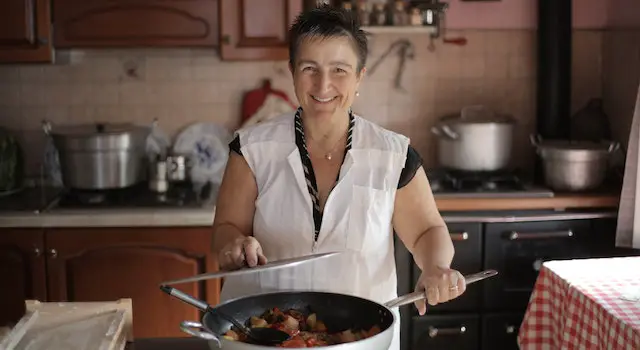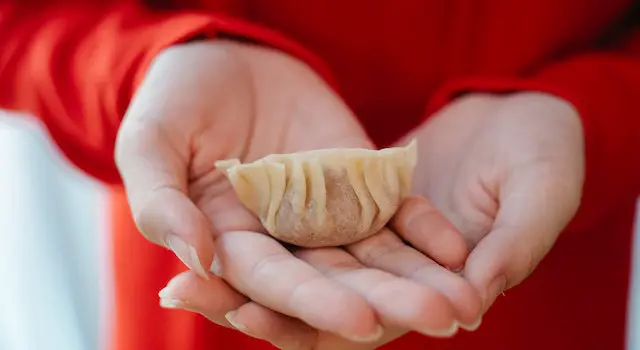How To Say Gyoza?
Gyoza is a Japanese dumpling typically made with a filling of ground meat and vegetables, wrapped in a thin dough, and then pan-fried. To say “gyoza” correctly, start by pronouncing the first syllable “go” as “ghee-oh” or “gee-oh” (rhyming with “meow”), with a hard “g” sound. The second syllable, “za,” should be pronounced as “ah” or “dza” (like the “za” in “pizza”), with a soft “z” sound. So, when put together, it is pronounced as “ghee-oh-ah” or “gee-oh-dza.” Remember that the pronunciation may vary slightly depending on regional accents or dialects.
Gyoza is a type of Japanese dumpling that has a rich history. It can be made with various fillings and can be boiled, steamed, or fried.
While gyoza can be eaten in many different ways, they are usually served with a dipping sauce. This is an important part of the gyoza experience.
Pronunciation
The Japanese word gyoza, which translates to dumpling, is the name for various savory and tasty dumplings filled with meat or vegetables. They can be boiled, fried, or steamed and are commonly eaten with a dipping sauce.
Typically, gyoza is made from ground pork, cabbage, ginger, and garlic. Alternatively, they can be filled with prawns, beef, or other types of meat. Gyoza is a popular food in Japan and can be found at many restaurants and street food stalls nationwide.
While gyoza can be prepared differently, they are primarily fried. They are a popular dish served with various dipping sauces and can be a great addition to any meal.
You will need a dough wrapper and a filling to make gyoza at home. Several gyoza wrappers are available in most stores, including some specifically designed for frying.
However, you can try making your own if you do not want to buy a ready-made wrapper. The process is fairly easy, and the results can be very satisfying.
There are several different types of gyoza, each with slightly different ingredients and cooking styles. For example, they can be boiled, steamed, or pan-fried.
The most common type of gyoza is the pan-fried gyoza, cooked in an oiled pan until brown and crispy on the bottom. Then, a mixture of water and cornstarch is added to the pan and covered to allow the gyoza to steam.
Often served with a dipping sauce, the pan-fried variety of gyoza is one of the most popular dishes in Japan. They are served as a side dish at many Chinese and ramen restaurants and in homes.
Several other varieties of gyoza are not as popular in Japan. Some are based on Chinese dim sum, while others contain shrimp and seafood. They can also be stuffed with cheese, natto (fermented soybeans), or a Japanese shiso herb.
Origin
There are a lot of different foods in the world, and many of them have an origin story. It could be because another dish inspired someone, or it might be that something that people ate in the past is still being served today. Whatever the case, it is important to know a little about the history of foods to understand how they came to be.
In the case of gyoza, there is a fairly strong story behind their origins. These dumplings are very old and have a long history in Japan. They were first eaten during Edo but were popular after WWII. During the war, Japanese soldiers in Manchuria developed a taste for Chinese dumplings and were able to bring these back with them to Japan.
After the war, they started to be fried in restaurants, and they became very popular. It is not entirely clear when the dumplings began being shaped like they are today, but it is thought that they may have originated in China around the Tang Dynasty.
They are made up of a dough, which is then filled with meat or vegetables and then boiled, steamed, or fried. They can be found in most restaurants as a side dish or snack and are often dipped in a sauce of some sort.
The dipping sauce is usually made up of soy sauce, rice vinegar, and a splash of chili oil. They are usually accompanied by shredded vegetables such as carrots, cabbage, and pickled ginger.
These dumplings are very popular in Japan and can be found in most Japanese restaurants. They are a great appetizer or light meal to share with your friends before diving into your main course.
There are several types of gyoza, including Yaki-Gyoza (fried dumplings), Sui-Gyoza (boiled dumplings), and Age-Gyoza (deep-fried dumplings). However, the most common type of gyoza is the Yaki-Gyoza, a crispy dumpling style.
There are a variety of fillings for these dumplings, which can include beef, chicken, prawns, fish, pork, and even mushrooms. In addition, they can be seasoned with soy sauce, Worcestershire sauce, and tamarind.
Meaning
Gyoza is a dumpling that originated in China but is now commonly eaten in Japan. These Chinese dumplings are filled with different ingredients and can be served in various ways. They can be boiled, steamed, or pan-fried and are usually served with a dipping sauce.
In Japan, gyoza is a popular dish often eaten as a main course at large family gatherings or as an okazu (side dish). They are also very popular as a meal accompaniment at ramen restaurants, sushi joints, and izakaya (bars).
These dumplings are made from dough filled with meat, vegetables, or both, and then they are either fried or steamed. They can also be served in a soup or mixed with other foods like noodles.
The most common type of gyoza is yaki gyoza, which is cooked by frying them in a pan before adding water and covering it for a few minutes. This helps steam them and create a thin crispy bottom on each dumpling.
Another type of gyoza is hanetsuki gyoza, made with several small pieces of dough that connect to form a single gyoza, with a thin crispy bottom on each piece. The yaki and hanetsuki types are sometimes served with a sweet dipping sauce.
There are many other variations of gyoza, including chicken, salmon, and vegetarian varieties. Each can be made with a different filling and have unique flavors, depending on the ingredients used.
They can be paired with dipping sauces, including soy sauce, Worcestershire sauce, and tamarind. Some people even add chili oil to their dipping sauces, a great way to add flavor and depth to the dumplings.
Aside from the traditional dipping sauce, a few other things can be added to the gyoza to make them even more delicious. For example, garlic and chili paste can be poured over the dumplings to create a delicious dip or salsa. You can also pour ponzu over them for an even more interesting flavor profile.
Variations
Gyoza is a popular Japanese dumpling that can be eaten boiled, steamed, or fried. It’s a delicious dish that is also easy to make at home.
Gyoza is made by wrapping various fillings inside a thin wheat flour wrapper. The fillings can include pork, cabbage, chives, or other vegetables.
In Japan, the most common gyoza filling is a mixture of minced pork and cabbage. However, more unconventional fillings, including prawn or other seafood and cheese, can be found. In addition, vegans and vegetarians should look out for gyoza filled with crumbled momen (soft) tofu.
Another popular type of gyoza is sui gyoza, served in broth. This is commonly served in winter and can be a comforting dish to eat on a cold day.
These gyoza are often served with a soy and vinegar dipping sauce. They may also be dipped in a ponzu or citrus soy dressing.
Although gyoza originated in China, they are now integral to Japanese culture. They can be found in restaurants nationwide and are a favorite among many Japanese people.
They can be steamed, boiled, or fried and come in different shapes and sizes, depending on what they have wrapped around. They are a popular snack for kids as well.
There are many ways to prepare gyoza, but the most traditional method is pan-frying the dumplings. This gives them the best mix of textures, with a crispy bottom and tender, soft tops that encase their juicy fillings.
While gyoza is traditionally seasoned with nira, onions, garlic, and ginger, it can also be flavored with other ingredients. For example, add chili oil to the gyoza filling to give them an extra kick.
If you want to make gyoza at home, you’ll need a few basic ingredients. First, you’ll need some cabbage leaves. You can wilt the cabbage by blanching it in water or microwaving it for a few minutes. If you don’t have time to do this, you can use frozen cabbage instead.
Once you have the ingredients, it’s time to start preparing the filling. To do this, peel the cabbage leaves and discard the thick core. Then, chop the leaves into small pieces.
How To Eat Gyoza
Gyoza is a popular Japanese dish that can be eaten as a main course or a side dish. You can find gyoza in many restaurants and at izakayas (bars or pubs).
These dumplings are made with minced meat, cabbage, and chives wrapped in a thin wonton wrapper. They’re a popular dish in Japan and are often served with a dipping sauce.
Filling
Gyoza is a type of dumpling that can be made from a variety of fillings. Some of the most common types of fillings include pork, shrimp, and vegetables. The fillings can be boiled, steamed, or pan-fried. The fillings are typically served with a dipping sauce, including soy sauce and ponzu.
When making gyoza, it is important to remember that you should not overfill the wrapper. Too much filling makes it difficult to fold the wrapper and can cause it to tear.
Mix minced pork, cabbage, and other ingredients to prepare the filling. Next, add scallions, chives, ginger, garlic, soy sauce, and toasted sesame oil to the filling. Mixing these ingredients thoroughly before placing the mixture inside a gyoza wrapper is best.
After mixing the filling, place a round gyoza wrapper on your palm and put a tablespoon in the center. Then, lightly moisten the edges of the wrapper and pleat it. Press the pleats tightly against the back of the wrapper with your other thumb and index finger.
Repeat this process until you have used all of the wrappers and filling. Then, you can freeze the remaining gyozas before cooking them.
Once the gyoza is prepared, cook them in a frying pan over medium heat. This will crisp up the bottoms and create a crispy texture for the gyoza. You can also add some water to the pan to cook them.
When the gyoza have finished cooking, they should be removed from the pan and placed on a serving platter. They should be topped with a dollop of dipping sauce and some shredded veggies.
This dipping sauce is a great way to add a different flavor profile to the gyoza. It contains soy sauce and ponzu, rich in umami flavors that combine to form a sweet, sour, and savory taste. The dipping sauce can be eaten alone or with other foods, such as noodles.
The dipping sauce is the perfect complement to gyoza and can be enjoyed on its own or as a dipping sauce for other dishes. It is often served with side dishes such as carrots, cabbage, and pickled ginger.
Wrapping
Gyoza is a popular Japanese dumpling consisting of ground pork, cabbage, chives, and other ingredients wrapped in a thin wrapper. It can be steamed, boiled, or pan-fried and is often served with a soy-based dipping sauce.
The wrapper is made from a simple dough of flour and water, which can be prepared in various ways. One simple method is to add all-purpose flour to a mixing bowl and then stream in hot water a few tablespoons at a time until the dough clumps together. Once the dough has formed, knead it until it is smooth and elastic.
Another option is to roll the wrapper out with a pasta machine until it is very thin. The thinner it is, the softer the dumpling will be when cooked. You can also make them with a rolling pin or cookie cutter.
Once the wrappers are ready, fill them with the meat and cabbage fillings. Some people like to make the fillings ahead of time and then freeze them before cooking.
When it comes to wrapping, there are two main techniques that you can use to create gyoza dumplings: fold them in half or make pleats. Pleats prevent the wrapper from bursting and make it more stretchy when sealed.
If you want to fold gyoza in half, put a teaspoon of the meat and cabbage filling in the middle of the wrapper and then lightly moisten the edges. Once you have created a few wrinkles on the side, press the fold together. Repeat this process about five more times.
Next, gently pinch the center of one of the pleats on either side. You will need to do this with your right hand if you are right-handed and your left if you are left-handed. Then, pinch the other corner on each side of the gyoza and press it together to form a tight, secure seal.
Once you have mastered the wrinkles, you can fill your gyoza and bake them in the oven or fry them in oil. The most common way to cook gyoza is to steam them, but you can also pan-fry them for a crispy outer coating.
Cooking
Gyoza (Jiao Zi), or pan-fried dumplings, are one of Japan’s most iconic foods. They are made with a thin wrapper and stuffed with a filling of ground meat, vegetables, and other ingredients. The dumplings are then cooked, boiled, steamed, or fried to produce a unique texture and taste.
Gyoza can be eaten alone or as an accompaniment to other dishes, such as ramen. They are a popular dish at restaurants, izakayas (Japanese pubs), and other social gatherings, as well as being a main course at family meals.
They are usually served in a dipping sauce, including soy sauce, rice vinegar, sugar, chili paste, or flakes. In addition, they are often served with shredded veggies like carrots, cabbage, and pickled ginger to dip into the sauce.
If you don’t have time to make gyoza from scratch, you can purchase them at most grocery stores and gourmet shops. However, the best way to enjoy gyoza is by making them from scratch at home. You can freeze the gyoza in a freezer bag or container to have them when needed!
The first step in making gyoza is to make the filling. This can combine cabbage, ground meat, chives, mushrooms, ginger, and soy sauce. The mixture should be finely chopped and seasoned with salt. It’s important to use very finely diced cabbage, as this will help ensure that the filling is firm and doesn’t become soggy when cooked.
After the filling has been prepared, you can start to make the wrappers. You can either roll the gyoza into oval shapes or use the shape of a fan to create a foldable wrap. You can also fold the wrappers in half, pinching them together at the top to seal them.
Heat up some vegetable oil in a non-stick frying pan over medium-high heat to cook the gyoza. When the oil is hot, place the gyoza in a single layer and cook for about 2 minutes on each side. This should result in a crispy bottom.
Serving
Gyoza, or potstickers or dumplings, is a delicious and nutritious dish that can be served in many ways. They can be fried, pan-fried, or even baked. They can also be topped with sweet and sour or dipping sauce.
You can fill gyoza with meat, such as pork, or vegetarian alternatives, like finely minced cabbage, carrots, and onions. You can also mix in other ingredients, such as teriyaki tofu.
Once you have filled your gyoza wrappers, it is time to fold them into pleats. You can do this with your thumb and forefinger by creating a pleat on each side of the wrapper, starting at the ends and working towards the center of the wrapper. If you find it difficult to form the pleats, try using a smaller filling and adding more as needed.
After you have formed your gyoza, you can now fry them in a frying pan over medium-high heat. You will want to cook them for about 3 minutes to achieve a seared crust on the bottom. If you want, you can add some water to the pan as well to help make the gyoza tender and cooked through.
When you finish, place the gyoza in a bowl and top it with a drizzle of soy sauce and vinegar. You can also garnish them with a drop of chili oil or garlic if you wish.
Traditionally, gyoza is served with soup and rice. However, you can also serve them on their own or as a part of a ramen meal. You can also enjoy them at family reunions and other events where people gather.
You can also freeze gyoza to prepare them in advance and serve them later. The frozen gyoza will also not reheat but can be cooked later.
When eating gyoza, it is important to be mindful of how much you are consuming. Eating a few gyozas in moderation is healthy, but overeating can lead to weight gain. The best way to avoid this is to limit your gyoza servings and use a healthier cooking method, such as boiling or steaming, instead of frying.
FAQ’s
How is “gyoza” pronounced?
“Gyoza” is pronounced as “gyoh-zuh” or “gyoh-suh”, depending on the accent.
What is a gyoza?
Gyoza is a Japanese dumpling that is typically filled with ground meat and vegetables, wrapped in a thin dough, and then pan-fried or boiled.
What are the ingredients of gyoza?
The ingredients of gyoza filling can vary, but typically include ground meat (such as pork or chicken), vegetables (such as cabbage or chives), ginger, garlic, soy sauce, and sesame oil.
Is gyoza a popular dish in Japan?
Yes, gyoza is a popular dish in Japan and is often served in izakayas (Japanese-style pubs) and ramen restaurants.
How do you eat gyoza?
Gyoza is often served as an appetizer or side dish and can be eaten with chopsticks or by hand. It is commonly dipped in a mixture of soy sauce, vinegar, and chili oil.
Are there any variations of gyoza?
Yes, there are many variations of gyoza that can include different fillings and cooking methods. For example, “age-gyoza” is deep-fried gyoza and “yaki-gyoza” is pan-fried gyoza. Some variations also use different wrappers, such as wheat or rice flour.



















